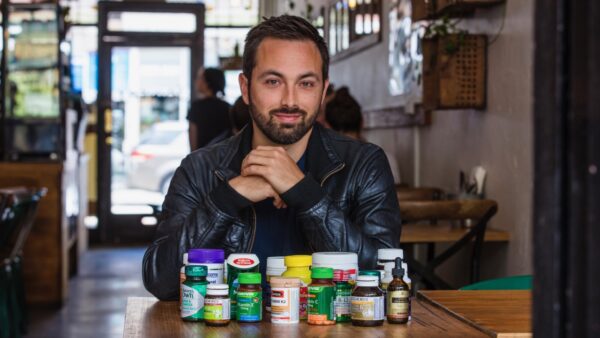
Vitamania, a film starring Dr. Derek Muller, available through various streaming platforms, released in August 2018.
Please, folks, please–watch this film! We watched it for the second time just last week, and I had the same reaction that I had the first time: I need to eat better, eat more fruits and vegetables, make sure I’m getting a good range of nutrients from my food. Because here’s the thing: we can’t eat a crummy diet and then think we’ll be okay if we just pop some vitamin pills. (And perhaps other supplements–I plan to re-watch the Frontline episode about that whole blah-de-blah soon, so watch for a review of that.) Vitamins are supposed to be consumed in our food. (Not to beat the drum or anything.)
Here’s some interesting info about one specific vitamin supplement that has gained popularity recently: Vitamin D. I had read in some dependable sources that it was thought to be somewhat helpful in warding off COVID-19. (News alert here: I GOT THE FIRST DOSE OF THE VACCINE THIS MORNING!!!! YAY!!!) Anyway, I live in Colorado where it gets pretty cold, so if I go outside I have to bundle up, and guess what? I put sunscreen on my face. So I probably don’t get much if any vitamin D from sunlight. But until I re-watched Vitamania, I had mistakenly thought that vitamin D was water soluble, like vitamin C, and so any excess would just be excreted. Which is wasteful but not especially harmful. However, vitamin D is fat soluble, just like vitamin A, which means that it can and does build up in your fat tissue. You can overdose on both of them. I take calcium/magnesium/vitamin D supplements at a much lower dose than recommended, but now I’ve cut that dosage even further. And I just threw out the vitamin D3 supplements that I had bought for Jim and Gideon to take, as I realized when I looked again at the label that they weren’t low-dose at all; they were 2,000 IUs per pill, which is, according to the label itself, 250% of the recommended Daily Value. I thought they were 50! But it’s 50 micrograms, technically a really, really, really tiny amount. IUs are yet tinier, weighing (barely) in at 1/40 of a microgram, which in turn is 1/1,000 of a milligram. It’s hard to imagine how miniscule these amounts are. Two scenes from the documentary are very helpful here, though: In one scene Dr. Muller is talking to one of the many solid experts who appear in the film, and she’s showing him a plate with the amounts of vitamins needed in a day. You can barely see the little dots of some items. But an even more graphic segment comes from a woman who accidentally poisoned her baby with too much vitamin D. She had twins, and she wasn’t able to nurse both of them, so she just nursed one and fed formula to the other. And she made her own recipe, which included one drop of the liquid vitamin D per batch. (And even that drop wouldn’t be pure vitamin D.) Guess how much she put in? A whole dropperful. She thought, ‘Hey, more is better.’ But the baby wasn’t thriving; she was shriveling. Meanwhile her twin was doing great. Thankfully a doctor figured it out in time, but the poor baby had to spend ten days in the hospital getting detoxed.
Below I’m including some short videos from or about the film. I believe we accessed it via Amazon Prime Video, paying $4.00. But you can also get it from the Vitamania website, and you’ll have the option to get the extended version for $9.99. That seems like the best option, and I wish we’d done that. Ho-kay. Watch the videos below, then watch the whole film, regular or extended, then go through all those bottles and jars that are living in your cabinet and from which you take that handful of pills every morning, and add things up. You may be horrified.